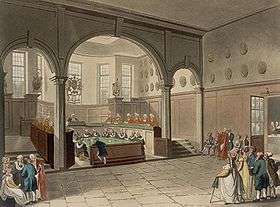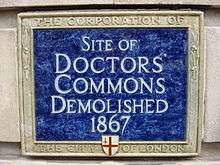Doctors' Commons
Doctors' Commons, also called the College of Civilians, was a society of lawyers practising civil law in London. Like the Inns of Court of the common lawyers, the society had buildings with rooms where its members lived and worked, and a large library. Court proceedings of the civil law courts were held in Doctors' Commons. The society used St Benet's, Paul's Wharf as its church.[1]

The "civil law" in England
While the English Common Law, unlike the legal systems on the European continent, developed mostly independently from Roman Law, some specialised English courts applied the Roman-based civil law. This is true of the ecclesiastical courts, whose practice even after the English Reformation continued to be based on the canon law of the Roman Catholic Church, but also of the admiralty courts. Until reforms in the 19th century, the ecclesiastical courts performed functions equivalent to today's probate courts and family courts.
The advocates practising in these courts were trained in canon law (before the Reformation) and Roman law (after the Reformation) at the universities of Oxford and Cambridge. The civilian legal profession was split like its common law counterpart. The advocates (the doctors) had a role similar to that of barristers in the common law courts, while the proctors had a role similar to that of attorneys in the common law courts or solicitors in the courts of equity.
According to some accounts, the society of Doctors' Commons was formed in 1511 by Richard Blodwell, Dean of the Arches. According to others, it existed already in the 15th century. The society's buildings, which were acquired in 1567, were originally situated near St. Paul's Cathedral at Paternoster Row,[2] and later nearby in Knightrider Street where it remained until the buildings were sold in 1865.[3]
In 1768 it was incorporated under the official name of College of Doctors of Law exercent in the Ecclesiastical and Admiralty Courts. The college consisted of a president (the Dean of Arches for the time being) and of those doctors of law who, having regularly taken that degree in either of the universities of Oxford or Cambridge, and having been admitted advocates in pursuance of the rescript of the archbishop of Canterbury, were elected "fellows" in the manner prescribed by the charter. There were also attached to the college thirty-four "proctors", whose duties were analogous to those of solicitors.[2]
Disestablishment

In the nineteenth century, the institution of Doctors' Commons and its members were looked upon as old-fashioned and slightly ridiculous. A satirical description of Doctors' Commons can be found in Charles Dickens's Sketches by Boz and also in his novel David Copperfield (in which Dickens called it a "cosey, dosey, old-fashioned, time-forgotten, sleepy-headed little family party." (ch. 23))
As anticipation of an impending abolition grew, there was a reluctance among the society to admit new fellows as this would dilute the proceeds of any winding up of the property. Dr Thomas Hutchinson Tristram was the last to be admitted.[4]
The Court of Probate Act 1857 abolished the testamentary jurisdiction of the ecclesiastical courts and gave common lawyers the right to practise in areas which before had been the exclusive domain of civilians, while offering the token compensation that the civilians could practise in the common law courts.[4] Critically, the Act also made it lawful for the Doctors' Commons, by a vote of the majority of its fellows, to dissolve itself and surrender its Royal Charter, the proceeds of dissolution to be shared among the members.[5]
Following this, the Matrimonial Causes Act 1857 created a new divorce court in which both barristers and advocates could appear. Then the High Court of Admiralty Act 1859 liberalised rights of audience in the Admiralty Court, leaving only the jurisdiction of the Court of Arches.[4]
A motion to dissolve the society was entered on 13 January 1858 and the last meeting took place on 10 July 1865. The fellows did not formally surrender their offices, nor in the end their charter, but the society perished with the death of its last fellow Dr. Thomas Hutchinson Tristram in 1912.[6] The buildings of Doctors' Commons were sold in 1865 and demolished soon after. The site is now largely occupied by the Faraday Building.
The Court of Arches itself finally admitted barristers, accepting that they could exercise all the offices of an advocate, in 1867.[4][7]
In popular culture
In the novel The Moonstone by Wilkie Collins, the solicitor of Gray's Inn Square Mathew Bruff notes, "I shall perhaps do well if I explain in this place, for the benefit of the few people who don't know it already, that the law allows all wills to be examined at Doctor's Commons by anybody who applies, on payment of a shilling fee."[8]
References
- "St Benet Paul's Wharf". Britain Express. Retrieved 1 August 2015.
- Chisholm 1911.
- Baker 1998, p. 59, n. 8.
- Squibb 1977, pp. 104-105.
- Court of Probate Act 1857, s.117
- Baker 1990, p. 194.
- Mouncey v. Robinson (1867) 37 L. J. Ecc. 8
- Collins 1998, pp. 274–275, 289.
Bibliography
- Baker, J.H. (1990). An Introduction to English Legal History. London: Butterworths. ISBN 0-406-53101-3.CS1 maint: ref=harv (link)
- Baker, J.H. (1998). Monuments of Endlesse Labours: English Canonists and Their Work 1300-1900. London: Hambledon Press. ISBN 1-85285-167-8.CS1 maint: ref=harv (link)

- Collins, Wilkie (1998) [1868]. Kemp, Sandra (ed.). The Moonstone. London: Penguin Books. ISBN 9780140434088.CS1 maint: ref=harv (link)
- Outhwaite, R.B.; Helmholz, R. H. (2007). The Rise and Fall of the English Ecclesiastical Courts, 1500-1860 ((Cambridge Studies in English Legal History) ed.). London: Cambridge University Press. ISBN 978-0-521-86938-6.CS1 maint: ref=harv (link)
- Squibb, G. D. (1977). Doctors' Commons. Oxford: University Press. ISBN 0-19-825339-7.CS1 maint: ref=harv (link)